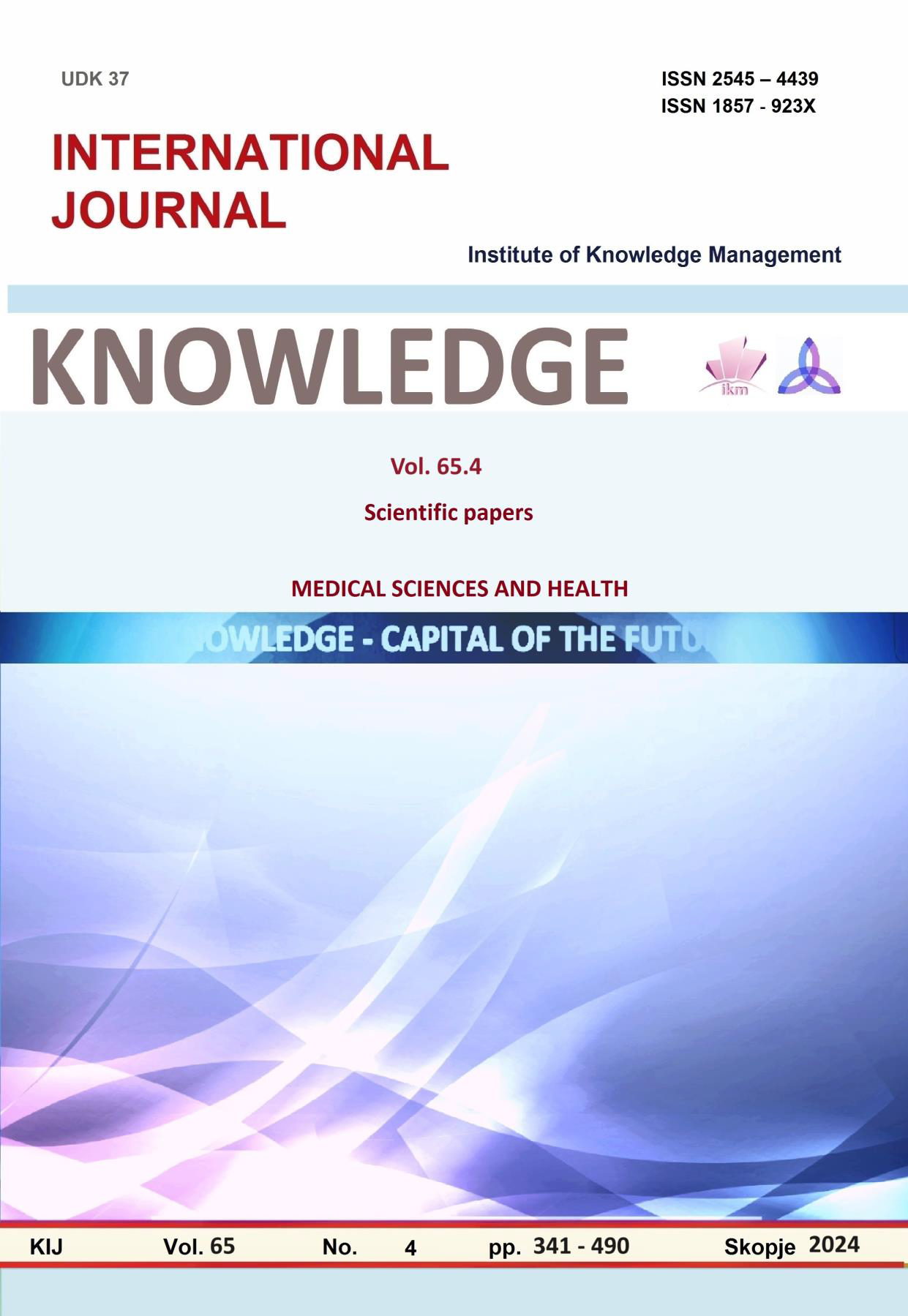PHARMACEUTICAL COMPOUNDING PREPARATIONS: A STUDY ON IBUPROFEN ORAL SUSPENSION
Keywords:
Compounded Ibuprofen Suspension, Galenic practice, Non-sterile preparationsAbstract
This study examines the formulation of pediatric ibuprofen suspension and the evaluation of its stability, in response to the optimized distribution issues of this drug regarding special patient requirements. The study was based on formulating an Ibuprofen oral suspension in a pediatric suitable dosage form (20mg/ml) using two different bases (sucrose and sodium carboxymethylcellulose) that satisfies the organoleptic properties for the paediatric age group. The formulations were evaluated for stability at two different storing conditions: room temperature (20 - 25°c) and refrigerator temperature (2 - 8°C). Each of the formulated suspension stored at different condition was measured for the concentration of Ibuprofen as the active ingredient and physical parameters (the refractive index and pH) on different periods (1, 3, 9, 12 and 15 days prior the formulation) to determine stability.
The content of Ibuprofen in the two formulations stored at two different conditions reflects within limit of percentege of content of Ibuprofen [90-110%]. The storage conditions significantly impact more the physical stability of ibuprofen, as evidenced by changes in the refractive index during the days after the formulation.
The results show that these galenic formulations can ensures stability and comparable quality to approved products. The pharmaceutical practice sector can still rely on compounding practices for special needs of the patients at special situations. Research focusing on the evaluation of the effectiveness and safety of galenic preparations can help improve the quality and confidence of patients and professionals in this field.
References
Barbagallo, M., & Sacerdote, P. (2019). Ibuprofen in the treatment of children’s inflammatory pain: A clinical and pharmacological overview. Minerva Pediatrica, 71, 82-99. https://doi.org/10.23736/S0026-4946.18.05453-
Boëman-Boer, Y., Fenton-May, V., & Le Brun, P. (Eds.). (2015). Pharmaceutical practice. Springer International Publishing. https://doi.org/10.1007/s11096-015-0229-6
Cutaia, K., Chablani, L., & Zhao, F. (2018). Basics of compounding: Vehicles for compounded oral liquid medications: A review. International Journal of Pharmaceutical Compounding, 22(6), 480-489. https://doi.org/10.18433/jpps30103
Davies, E. H., &Tuleu, C. (2008). Medicines for children: A matter of taste. Journal of Pediatrics. https://doi.org/10.1016/j.jpeds.2008.06.030
Durresi, S. (2004). Pergatitje galenike e kozmetike. Tirana.
European Association of Hospital Pharmacists. (2016). Compounding of medicines in hospital pharmacy. EAHP Statements. Last update: 17 November 2020.
European Association of Hospital Pharmacists. (2020). Position paper on pharmacy preparations and compounding.
European Parliament and Council. (2001). Directive 2001/83/EC of the European Parliament and of the Council of 6 November 2001 on the Community code relating to medicinal products for human use. EUR-Lex.
Marques Marinho, F. (2013). Cellulose and its derivatives use in the pharmaceutical compounding practice. In E. B. Souto (Ed.), *Cellulose - medical, pharmaceutical and electronic applications* (pp. 141-162). InTechOpen. https://doi.org/10.5772/56637
Medeiros, J. R., Cortes, M., &Romo, E. (2017). Comparison of the USP apparatus 2 and 4 for testing the in vitro release performance of ibuprofen generic suspensions. International Journal of Applied Pharmaceutics, 9(4), 90-95. https://doi.org/10.22159/ijap.2017v9i4.19926
McClymer, J. P. (2016). Precise determination of the refractive index of suspended particles: Light transmission as a function of refractive index mismatch. American Journal of Physics, 84, 602-605. https://doi.org/10.1119/1.4948993
Mohan, S., Kato, E., Drennen, J. K., III, & Anderson, C. A. (2019). Refractive index measurement of pharmaceutical solids: A review of measurement methods and pharmaceutical applications. Journal of Pharmaceutical Sciences, 108(11), 3478-3495. https://doi.org/10.1016/j.xphs.2019.06.029
Moriarty, C., & Carroll, W. (2016). Ibuprofen in paediatrics: Pharmacology, prescribing and controversies. Archives of Disease in Childhood - Education and Practice, 101, 327-330.
Rehman, A., Ijaz, A. S., Murtaza, G., & Hussain, I. (2012). Prediction of chemical stability of ibuprofen in solution: An accelerated aging study. Asian Journal of Chemistry, 24(11), 4939-4943. https://doi.org/10.14233/ajchem.2012.13883
Sankeshwari, S., HV, G., KM, A., Eliyas, A., Thirumaleshwar, S., &HarshaVardhan, P. V. (2023). A review on the solid oral dosage form for pediatrics, regulatory aspects, challenges involved during the formulation, and toxicity of the excipients used in pediatric formulation. International Journal of Applied Pharmaceutics, 15(3), 12-27. https://doi.org/10.22159/ijap.2023v15i3.47313
Schirm, E., Tobi, H., de Vries, T. W., Choonara, I., & de Jong-van den Berg, L. T. W. (2003). Lack of appropriate formulations of medicines for children in the community. Acta Paediatrica, 92, 1486-1489. https://doi.org/10.1111/j.1651-2227.2003.tb00837.x
Shachar, C., Gruppuso, P. A., & Adashi, E. Y. (2023). Pediatric drug and other shortages in the age of supply chain disruption. JAMA, 329(24), 2127-2128. https://doi.org/10.1001/jama.2023.4755
Sudhir, M., Divya, C. H., Prasanti, N. L., & Jyothi, N. (2016). Formulation and characterization of oral suspension containing ibuprofen. Asian Journal of Pharmaceutical Technology & Innovation, 4(21), 23-32.
Tucci, J., Bandiera, E., Darwiche, R., Medos, Z., Nashed, R., & Trinh, D. (2009). Paracetamol and ibuprofen for paediatric pain and fever. Journal of Pharmacy Practice and Research, 39(3).
U.S. Food and Drug Administration. (2007). MOTRIN® (ibuprofen) suspension 100 mg/5 mL [Drug label].
U.S. Food and Drug Administration. (2018). Compounding and the FDA: Questions and answers. [PDF file]. Retrieved February 10, 2024, from https://www.fda.gov/media/94393/download
United States Pharmacopeia and National Formulary USP 40-NF 35. (2017). The United States Pharmacopeial Convention, Inc: Rockville, MD.
United States Pharmacopeial Convention. The United States Pharmacopeia-National Formulary. Rockville: United States Pharmacopeia; 2011. p. 1416-19
United States Pharmacopeial Convention. (2009). The United States Pharmacopeia 32 and the National Formulary 27 (USP 32-NF 27). Rockville, MD: United States Pharmacopeial Convention. pp. 1367
Wiederseiner, S., Andreini, N., Epely-Chauvin, G., &Ancey, C. (2011). Refractive-index and density matching in concentrated particle suspensions: A review. Experiments in Fluids, 50, 1183-1206. https://doi.org/10.1007/s00348-010-0996-8





